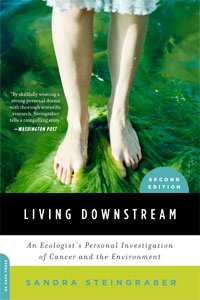Share
Related Topics
Tagged As
Sandra Steingraber begins her book with what appears to be a common story. Her mother was diagnosed with breast cancer at age 44, while her aunt died of bladder cancer, specifically traditional cell carcinoma, the same cancer that the author herself has battled. We might assume it’s another story of genetic predisposition to having cancer passed on from one generation to the next. Then she adds a statement that unravels this assumption: She is adopted. She adds that statistically the risk of cancer in adoptees has more to do with whether their adopted parents died of cancer rather than their biological parents.
We do not strictly control Google ad content. If you believe any Google ad is inappropriate, please email us directly here.
 This highlights the reoccurring theme of Living Downstream: a person’s environmental exposures have a significant effect on cancer development. In her book Steingraber details six trends in understanding and preventing the causes of cancer, mainly:
This highlights the reoccurring theme of Living Downstream: a person’s environmental exposures have a significant effect on cancer development. In her book Steingraber details six trends in understanding and preventing the causes of cancer, mainly:1. The complexity of cancer causes
2. The import of epigenetics (carcinogens changing the behavior of genes)
3. The role of endocrine disruption
4. The timing of chemical exposure affecting its severity (e.g., developmental stages of growth)
5. The need to analyze chemical mixtures, not just single chemicals
6. The precautionary principle as a guide when introducing chemicals to the environment
While Steingraber delves into scientific detail as a biologist, she does so in a way that an average reader can understand. She includes published research, statistics, and human and animal studies to support her conclusions. Between the pages of research, she includes a memoir of her origins, especially noting the environmental aspects that may have contributed to her development of cancer.
Based on her own experience and research, Steingraber encourages readers to explore their environmental heritage. She points out common sources of carcinogens and potential carcinogens, such as incinerator, agricultural, and industrial byproducts, and that proximity to these, especially during developmental stages in life, can increase cancer risk.
Steingraber concludes by emphasizing the statistical significance of environmentally-caused cancer in the U.S., mainly, more people die by cancer caused by involuntary environmental exposure each year than by homicides or suicides. She encourages changes such as buying local organic produce and investing in greener, rather than petroleum-based energy sources to improve both our health and that of future generations.
As almost everyone has been affected by cancer in some way, reading Living Downstream can be an insightful book into discovering how the environment can impact your long-term health and of your loved ones. We recommend this book for all HHI readers to raise awareness of the impact our air, water, food, and building materials can have on our health and wellbeing.
For publisher information, see our book listing.
HHI Error Correction Policy
HHI is committed to accuracy of content and correcting information that is incomplete or inaccurate. With our broad scope of coverage of healthful indoor environments, and desire to rapidly publish info to benefit the community, mistakes are inevitable. HHI has established an error correction policy to welcome corrections or enhancements to our information. Please help us improve the quality of our content by contacting allen@healthyhouseinstitute.com with corrections or suggestions for improvement. Each contact will receive a respectful reply.
The Healthy House Institute (HHI), a for-profit educational LLC, provides the information on HealthyHouseInstitute.com as a free service to the public. The intent is to disseminate accurate, verified and science-based information on creating healthy home environments.
While an effort is made to ensure the quality of the content and credibility of sources listed on this site, HHI provides no warranty - expressed or implied - and assumes no legal liability for the accuracy, completeness, or usefulness of any information, product or process disclosed on or in conjunction with the site. The views and opinions of the authors or originators expressed herein do not necessarily state or reflect those of HHI: its principals, executives, Board members, advisors or affiliates.
(Note: The views expressed in this blog post are those of the author, and do not necessarily represent those of The Healthy House Institute, LLC.)








